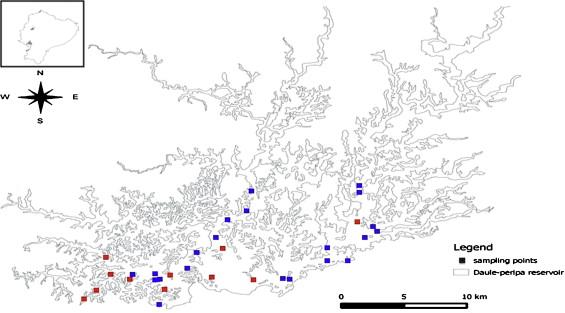Habitat suitability of the invasive water hyacinth and its relation to water quality and macroinvertebrate diversity in a tropical reservoir |
| |
| Affiliation: | 1. Ghent University, Laboratory of Environmental Toxicology and Aquatic Ecology, J. Plateaustraat 22, B-9000 Ghent, Belgium;2. Research Institute for Aquaculture No. 1, Dinh Bang, Tu Son, Bac Ninh, Viet Nam;3. Escuela Superior Politécnica del Litoral (ESPOL), Facultad de Ciencias Naturales y Matemáticas, Campus Gustavo Galindo, Km. 30.5 Vía Perimetral, P.O. Box 09-01-5863, Guayaquil, Ecuador;4. Hanoi University of Science and Technology, School of Environmental Science and Technology, No. 1 Dai Co Viet, Hanoi, Viet Nam |
| |
| Abstract: | 
In this study, we assessed the relationship between the occurrence of the invasive water hyacinth (Eichhornia crassipes) and water quality properties as well as macroinvertebrate diversity in a tropical reservoir, situated in western Ecuador. Macroinvertebrates and physico-chemical water quality variables were sampled at 32 locations (during the dry season of 2013) in both sites covered and non-covered by water hyacinth in the Daule-Peripa reservoir. The results indicated that, in terms of water quality, only turbidity was significantly different between sampling sites with and without water hyacinth (Mann–Whitney U-test, p < 0.01). The habitat suitability model showed that water hyacinth was present at sites with a low turbidity. The percentage water hyacinth cover increased with decreasing turbidity. The Biological Monitoring Working Party-Colombia score and the Margalef diversity index were significantly higher (Mann–Whitney U-test, p < 0.01) at sampling sites where water hyacinth was present compared to water hyacinth absent sites. However, there were no significant differences in the Shannon–Wiener index, Evenness index and Simpson index between the sampling sites with and without water hyacinth. Our results suggest that water hyacinth cover was an important variable affecting the diversity of macroinvertebrates in the Daule-Peripa reservoir, with intermediate levels of water hyacinth cover having a positive effect on the diversity of macroinvertebrates. Information on the habitat suitability of water hyacinth and its effect on the physico-chemical water quality and the macroinvertebrate community are essential to develop conservation and management programs for large tropical reservoirs such as the Daule-Peripa reservoir and the Guayas river basin, where water resources are being at high risk due to expansion of agricultural and industrial development activities. |
| |
| Keywords: | Daule-Peripa reservoir Invasive species Water hyacinth Macroinvertebrates Water quality |
| 本文献已被 ScienceDirect 等数据库收录! |
|

